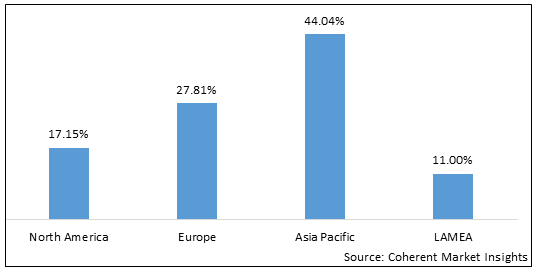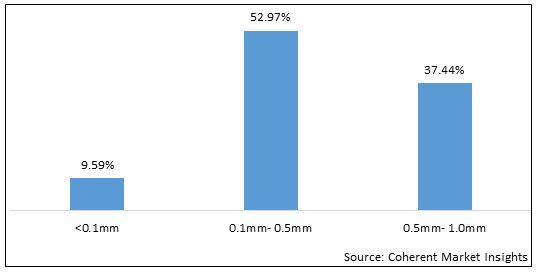Ultra-Thin Glass Market is estimated to be valued at USD 14.36 Bn in 2025 and is expected to reach USD 23.36 Bn in 2032, exhibiting a compound annual growth rate (CAGR) of 7.2% from 2025 to 2032. Factors that are likely to fuel the market growth of ultra-thin glass include increasing consumption of electronic devices, especially smartphones and flat-screen displays. These devices offer the highest display sizes and require a large amount of ultra-thin glass to meet the requirements.
Global Ultra-Thin Glass Market: Regional Insights
Based on geography, the global ultra-thin glass market is segmented into North America, Europe, Asia Pacific, Latin America, and Middle East & Africa.
Asia Pacific is estimated to hold leading position in the global market over the forecast period. This is mainly due to the growing electronics industry and rising consumer disposable income in countries such as China and India. This region also has an inclination towards the automobile sector, which is expected to fuel product demand for ultra-thin glass.
Europe is expected to hold second largest geographic segment in the global ultra-thin glass market, and it has a growing automotive sector, which is expected to drive regional growth. Moreover, the increasing use of ultra-thin glass in the solar sector is expected to provide a lucrative opportunity for the market players.
North America is the third largest market for ultra-thin glass in the world. It is expected to increase its share in the market owing to the high growth of the electronics industry in this region.
Figure 1. Global Ultra-Thin Glass Market By Region 2025

To learn more about this report, Request sample copy
Global Ultra-Thin Glass Market Drivers:
Growing demand for consumer electronics to augment market growth
Thin-glasses are widely used in the manufacturing of electronic products such as touch screen displays, LCDs, OLED displays, and other electronic devices. Moreover, it has a low thermal conductivity and high UV resistance, which means that it can be used for display applications without additional polishing. It is also resistant to scratches and abrasion, which makes it ideal for the curved surfaces of many products. The market for ultra-thin glass is primarily driven by the increasing popularity of the end-use industries such as consumer electronics.
Growing demand from light weight dual skin façade to foster market growth
Using this material to create a light weight dual skins facade or retrofitting an existing structure can be a cost-effective and creative way of designing next project. It can be a viable alternative to insulated glass units and is lightweight, flexible, and incredibly resistant to UV rays. There are many types of ultra-thin glass available, and some are more susceptible to breakage than others.
Global Ultra-Thin Glass Market Opportunities:
Growing use of ultra-thin glass in agriculture sector to provide significant opportunities for market growth. The demand for ultra-thin glass in the agricultural sector is increasing due to its insulating properties. This glass is also known for its lightweight and can be used in greenhouses. Its high light transmittance and insulating properties help increase plant growth, thereby boosting production.
Ongoing research and developments activities in the field is expected to provide bright market opportunities. For instance, in June 2021, Australian and European researchers developed the ultra-thin film, made of a semiconductor called gallium arsenide, could also be used to develop compact and flexible infrared sensors.
Ultra-Thin Glass Market Report Coverage
| Report Coverage | Details | ||
|---|---|---|---|
| Base Year: | 2024 | Market Size in 2025: | USD 14.36 Bn |
| Historical Data for: | 2020 To 2024 | Forecast Period: | 2025 To 2032 |
| Forecast Period 2025 to 2032 CAGR: | 7.2% | 2032 Value Projection: | USD 23.36 Bn |
| Geographies covered: |
|
||
| Segments covered: |
|
||
| Companies covered: |
Corning Inc. , AGC Inc., , Schott AG, , Nippon Electric Glass Co., Ltd., , Central Glass Co., Ltd., Xinyi Glass Holdings Limited, AIR-CRAFTGLASS, NOVALGLASS, and Tawian Glass Group |
||
| Growth Drivers: |
|
||
| Restraints & Challenges: |
|
||
Uncover macros and micros vetted on 75+ parameters: Get instant access to report
Global Ultra-Thin Glass Market Trends:
Innovation in development of process
In recent years, manufacturers have developed new ways to create thin glass that is as flexible and durable as it is light. For instance, fused deposition modeling technique is a new technique. This method combines powdered materials, such as silicon, with liquid resins, and a heat source to melt them together. The main advantage of this process is that it is cost-effective and environmentally friendly. It is also highly scalable and has a high production rate. In addition, the product can be produced in a wide range of sizes and shapes.
Growing focus on reducing carbon footprint
It is an option for reducing carbon footprint, as it is a renewable and recyclable material. The market for this type of glass is expected to grow significantly over the forecast period, as it can be used in a wide range of industries. Moreover, they highly durable and can withstand wear and tear.
Global Ultra-Thin Glass Market Restraints:
High cost of raw materials is hindering market growth
The high cost of raw materials and manufacturing process is limiting the growth of the market. Also, the Covid-19 pandemic has impacted the ultra-thin glass market negatively by restricting the movement of workers and reducing their operational efficiency.
Fragile nature and availability of substitute is hampering market growth
Silicone-based alternatives are gaining importance as alternative to high cost ultra-thin glass. Moreover, the screen produce from ultra-thin glass used in electronics display is not ideal for hammering or large impact unlike plastic-based displays, which can resist huge impact. These factors are expected to hamper the market growth. However, growing research and development activities in the field will positively impact the market growth.
Figure 2. Global Ultra-Thin Glass Market, By Thickness Type 2025

To learn more about this report, Request sample copy
Global Ultra-Thin Glass Market Segmentation:
The global ultra-thin glass market report is segmented into Thickness Type, Application, and Region
Based on Thickness Type, the market is segmented into <0.1mm, 0.1mm-0.5mm, and 0.5mm-1.0mm. Out of which, 0.1mm-0.5mm is expected to dominate the global market over the forecast period. The 0.1mm-0.5mm segment was the highest contributor to the market, with 482.2 million square meter in 2025, and is estimated to reach 810.11 million square meter by 2032, growing at a CAGR of 6.7% during the forecast period.
<0.1mm segment is also expected to witness significant growth in the near future owing to the growing demand from consumer electronics and automotive interior panels.
Based on Application, the market is segmented into Consumer Electronics, Automotive & Transportation, Medical & Healthcare, and Others. Out of which, Consumer Electronics is expected to dominate the global market over the forecast period. Ultra-thin glass with thickness below 0.5 mm is widely used in consumer electronics, due to high heat resistance and flexibility property.
Automotive & Transportation segment is also expected to witness significant growth in the near future and this is owing to the growing use of ultra-thin glass in fabricating lightweight windscreens, complex curved glass panels, and ultra-thin window.
Global Ultra-Thin Glass Market: Key Developments
In February 2023, CAP-XX Limited, a marketer in the design and manufacture of supercapacitors and energy management systems, announced the launch of its DMV750 ultra-thin 2.2mm prismatic 3V supercapacitor to provide high performance for IoT, medical and other space-constrained and mission-critical electronic devices.
In June 2020, Samsung Electronics entered into a partnership with Corning to develop its own ultra-thin glass for foldable smartphones. This is expected to expand Corning’s ultra-thin glass market size in the consumer electronics segment.
In May 2020, Schott AG introduced Xensation Flex, flexible ultra-thin glass for foldable displays and flip phones. This is expected to expand the company’s market size in the ultra-thin glass market targeting new customers in the consumer electronics market.
Global Ultra-Thin Glass Market: Key Companies Insights
The global ultra-thin glass market is highly competitive. This is attributed to continuous launch of new technologies due to ongoing R &D and efforts by value chain participants. Moreover, key players are adopting various business growth strategies in order to expand their presence on regional as well as global basis. Some of the key players in the global ultra-thin glass market are Corning Inc., AGC Inc., Schott AG, , Nippon Electric Glass Co., Ltd., , Central Glass Co., Ltd., Xinyi Glass Holdings Limited, AIR-CRAFTGLASS, NOVALGLASS, and Tawian Glass Group
*Definition: Ultra-thin glass can be used in a variety of applications, from solar mirrors to medical instruments and electronic components. It also has a number of other advantages, including chemical resistance and gas barrier properties.
Share
Share
About Author
Vidyesh Swar is a seasoned Consultant with a diverse background in market research and business consulting. With over 6 years of experience, Vidyesh has established a strong reputation for his proficiency in market estimations, supplier landscape analysis, and market share assessments for tailored research solution. Using his deep industry knowledge and analytical skills, he provides valuable insights and strategic recommendations, enabling clients to make informed decisions and navigate complex business landscapes.
Missing comfort of reading report in your local language? Find your preferred language :
Transform your Strategy with Exclusive Trending Reports :
Frequently Asked Questions
Select a License Type
Credibility and Certifications

860519526

9001:2015
27001:2022


Joining thousands of companies around the world committed to making the Excellent Business Solutions.
View All Our Clients
US Reciprocal Tax Impact Analysis On Ultra-Thin Glass Market
Stay updated on tariff changes with expert insights and timely information